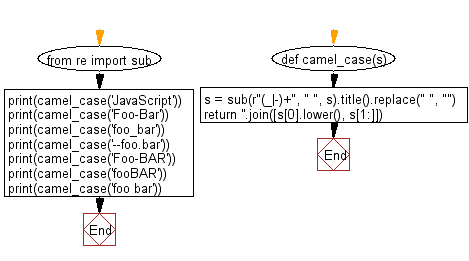Python: Convert a given string to camelcase
Python String: Exercise-96 with Solution
From Wikipedia,
Camel case (sometimes stylized as camelCase or CamelCase; also known as camel caps or more formally as medial capitals) is the practice of writing phrases without spaces or punctuation, indicating the separation of words with a single capitalized letter, and the first word starting with either case.
Write a Python program to convert a given string to camelcase.
- Use re.sub() to replace any - or _ with a space, using the regexp r"(_|-)+".
- Use str.title() to capitalize the first letter of each word and convert the rest to lowercase.
- Finally, use str.replace() to remove spaces between words.
Sample Solution:
Python Code:
from re import sub
def camel_case(s):
s = sub(r"(_|-)+", " ", s).title().replace(" ", "")
return ''.join([s[0].lower(), s[1:]])
print(camel_case('JavaScript'))
print(camel_case('Foo-Bar'))
print(camel_case('foo_bar'))
print(camel_case('--foo.bar'))
print(camel_case('Foo-BAR'))
print(camel_case('fooBAR'))
print(camel_case('foo bar'))
Sample Output:
javascript fooBar fooBar foo.Bar fooBar foobar fooBar
Flowchart:

Visualize Python code execution:
The following tool visualize what the computer is doing step-by-step as it executes the said program:
Python Code Editor:
Have another way to solve this solution? Contribute your code (and comments) through Disqus.
Previous: Write a Python program to convert the values of RGB components to a hexadecimal color code.
Next: Write a Python program to convert a given string to snake case.
What is the difficulty level of this exercise?
Test your Programming skills with w3resource's quiz.
Python: Tips of the Day
Find current directory and file's directory:
To get the full path to the directory a Python file is contained in, write this in that file:
import os dir_path = os.path.dirname(os.path.realpath(__file__))
(Note that the incantation above won't work if you've already used os.chdir() to change your current working directory, since the value of the __file__ constant is relative to the current working directory and is not changed by an os.chdir() call.)
To get the current working directory use
import os cwd = os.getcwd()
Documentation references for the modules, constants and functions used above:
- The os and os.path modules.
- The __file__ constant
- os.path.realpath(path) (returns "the canonical path of the specified filename, eliminating any symbolic links encountered in the path")
- os.path.dirname(path) (returns "the directory name of pathname path")
- os.getcwd() (returns "a string representing the current working directory")
- os.chdir(path) ("change the current working directory to path")
Ref: https://bit.ly/3fy0R6m
- New Content published on w3resource:
- HTML-CSS Practical: Exercises, Practice, Solution
- Java Regular Expression: Exercises, Practice, Solution
- Scala Programming Exercises, Practice, Solution
- Python Itertools exercises
- Python Numpy exercises
- Python GeoPy Package exercises
- Python Pandas exercises
- Python nltk exercises
- Python BeautifulSoup exercises
- Form Template
- Composer - PHP Package Manager
- PHPUnit - PHP Testing
- Laravel - PHP Framework
- Angular - JavaScript Framework
- Vue - JavaScript Framework
- Jest - JavaScript Testing Framework
